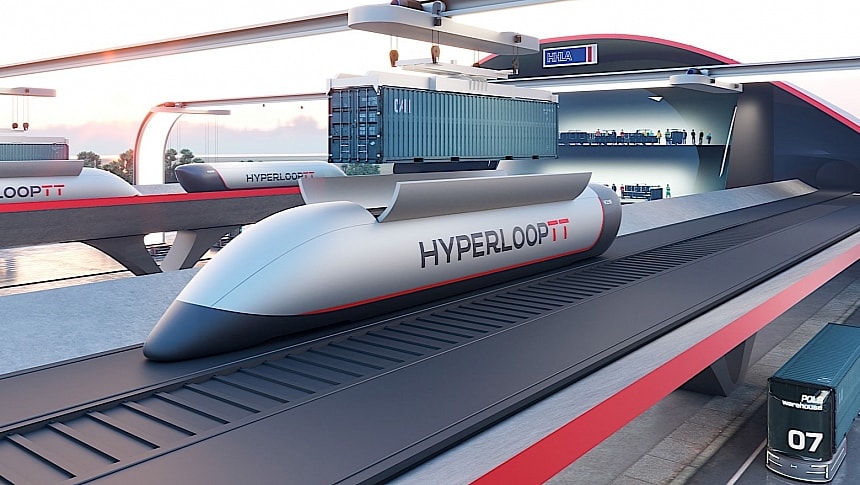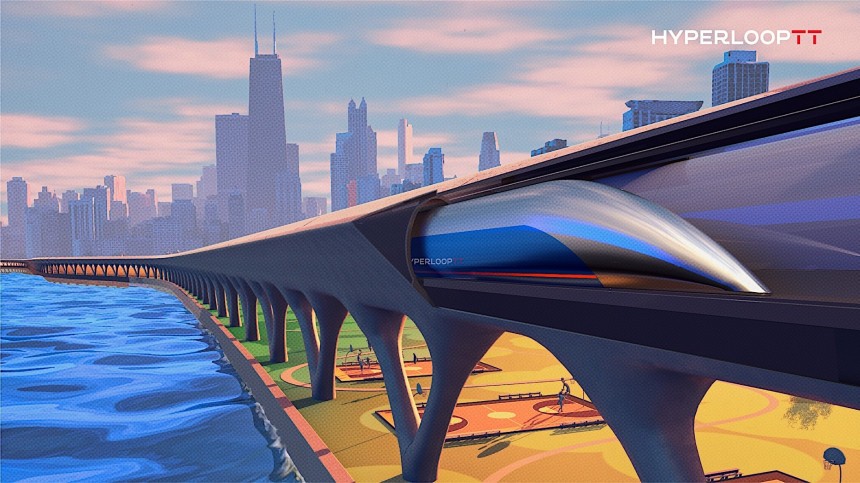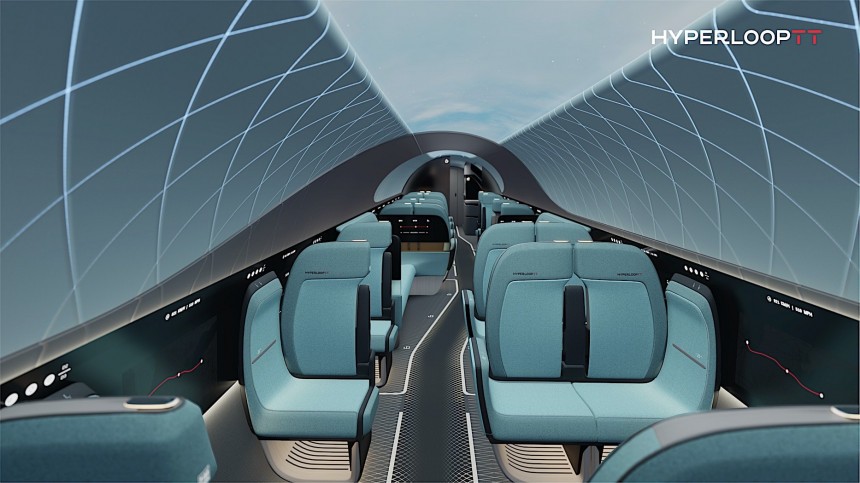For a brief period of time not long ago the word "hyperloop” was on everybody's lips. Popularized by Elon Musk in a 2013 white paper, the idea of high-speed travel through a low-pressure tube and using capsules is all but dead. Or is it?
Not long ago there were three companies working on this: the Elon Musk-founded The Boring Company, Richard Branson's Hyperloop One (aka Virgin Hyperloop), and Hyperloop Transportation Technologies (HyperloopTT).
As you all know, The Boring Company was building a test tunnel in California to prove Musk's theory that capsules made from aluminum and filled with people or cargo could reach speeds of up to 760 mph (1,223 kph) inside airless tubes. Only his tunnel was not nearly airless, there were only people on foot and the occasional Teslas that went through it, and that spelled doom for the project.
Hyperloop One on the other hand didn't even get nearly as far. A couple of test pods were made, but they got nowhere, not even inside a tunnel, so the company decided to call it quits at the end of last year.
This brings us to HyperloopTT, the only one of the original three companies playing in this field that is still standing. Not only standing, but thriving, it seems, as a major step forward for the company was announced this week.
This crew was set up in 2013 in California with the declared goal of creating a means of transport that can reach "airplane speeds on the ground." It conducted its first major feasibility study in 2019, and given how that proved this idea could work, money started flowing.
HyperloopTT presently has ongoing projects in a couple of regions in Europe. In Veneto, Italy, it is working on creating a prototype hyperloop transportation system to link the cities of Venice-Mestre to Padua.
The project is called HyperTransfer, and aims to "reduce heavy traffic, decrease traditional transport times and energy consumption, improve road safety, and enhance the interconnections between transport systems and smart cities in the local area." It will be, for all intents and purposes, the world's first operational commercial hyperloop system.
Over in Germany something called the HyperPort exists. Located in the Port of Hamburg, it's an effort meant to create a high-speed transportation solution for shipping containers both inside the port and further inland.
Work on the technologies to be deployed in these projects was until this week conducted at a research and development center in Toulouse, France. But, given how back in January the contract for the Italian HyperTransfer was signed, HyperloopTT decided to move R&D operations to the country that gives us Ferraris and Ducatis.
The company will establish several centers in the European country. The offices will be located near Venice, with some work to be conducted in Puglia as well. For that to happen, the company will have to move in from France a lot of hardware, including the capsules that are the stars of the transportation system, the vacuum pumps used to pull air from the test tracks, the levitation and propulsion systems, and, naturally, the control center.
We're told that, partially, the decision to move operations was also fueled by the fact the location in France did not have enough land for the needs of HyperloopTT's testing procedures – to be properly put through its paces, the system needs "tens of kilometers" of track.
The relocation of HyperloopTT's operations will take about six months. Neither the project in Italy nor the one in Germany have set completion deadlines.
The last we heard about HyperloopTT before this week's announcement was back in the fall of last year, when we were given a taste of the Express Freight concept for moving cargo (check the second video below).
Meant to take advantage of the speed of a hyperloop system, the capsules are also meant to revolutionize how freight is loaded and transported as well. The floors of each Freight pod are lowered, and there is a pocket door between the structural ribs in a bid to gain more space.
Loading and unloading them could be made autonomously and simultaneously, thanks to staggered doors fitted on both sides of the pod – in essence, one side is used for unloading and the other for loading as soon as space becomes available. Because of a special system called DockLock, the pods can easily connect to existing infrastructure.
As for the people-carrying variant of the pod, at its finest the contraption will be capable of holding up to 48 passengers in a space about as large as that inside a small commercial aircraft. The pods would shoot through tubes with a diameter of 13 feet (four meters), levitating on a near-frictionless magnetic field.
There is no deadline for when we could be experiencing these pods firsthand either.
As you all know, The Boring Company was building a test tunnel in California to prove Musk's theory that capsules made from aluminum and filled with people or cargo could reach speeds of up to 760 mph (1,223 kph) inside airless tubes. Only his tunnel was not nearly airless, there were only people on foot and the occasional Teslas that went through it, and that spelled doom for the project.
Hyperloop One on the other hand didn't even get nearly as far. A couple of test pods were made, but they got nowhere, not even inside a tunnel, so the company decided to call it quits at the end of last year.
This brings us to HyperloopTT, the only one of the original three companies playing in this field that is still standing. Not only standing, but thriving, it seems, as a major step forward for the company was announced this week.
This crew was set up in 2013 in California with the declared goal of creating a means of transport that can reach "airplane speeds on the ground." It conducted its first major feasibility study in 2019, and given how that proved this idea could work, money started flowing.
HyperloopTT presently has ongoing projects in a couple of regions in Europe. In Veneto, Italy, it is working on creating a prototype hyperloop transportation system to link the cities of Venice-Mestre to Padua.
Over in Germany something called the HyperPort exists. Located in the Port of Hamburg, it's an effort meant to create a high-speed transportation solution for shipping containers both inside the port and further inland.
Work on the technologies to be deployed in these projects was until this week conducted at a research and development center in Toulouse, France. But, given how back in January the contract for the Italian HyperTransfer was signed, HyperloopTT decided to move R&D operations to the country that gives us Ferraris and Ducatis.
The company will establish several centers in the European country. The offices will be located near Venice, with some work to be conducted in Puglia as well. For that to happen, the company will have to move in from France a lot of hardware, including the capsules that are the stars of the transportation system, the vacuum pumps used to pull air from the test tracks, the levitation and propulsion systems, and, naturally, the control center.
We're told that, partially, the decision to move operations was also fueled by the fact the location in France did not have enough land for the needs of HyperloopTT's testing procedures – to be properly put through its paces, the system needs "tens of kilometers" of track.
The relocation of HyperloopTT's operations will take about six months. Neither the project in Italy nor the one in Germany have set completion deadlines.
Meant to take advantage of the speed of a hyperloop system, the capsules are also meant to revolutionize how freight is loaded and transported as well. The floors of each Freight pod are lowered, and there is a pocket door between the structural ribs in a bid to gain more space.
Loading and unloading them could be made autonomously and simultaneously, thanks to staggered doors fitted on both sides of the pod – in essence, one side is used for unloading and the other for loading as soon as space becomes available. Because of a special system called DockLock, the pods can easily connect to existing infrastructure.
As for the people-carrying variant of the pod, at its finest the contraption will be capable of holding up to 48 passengers in a space about as large as that inside a small commercial aircraft. The pods would shoot through tubes with a diameter of 13 feet (four meters), levitating on a near-frictionless magnetic field.
There is no deadline for when we could be experiencing these pods firsthand either.




















































